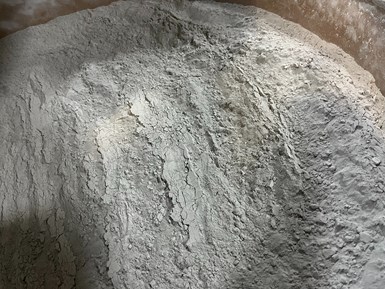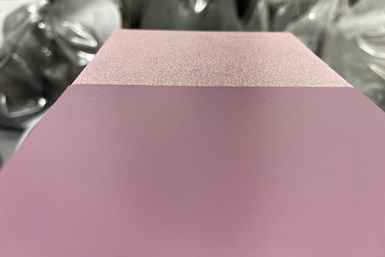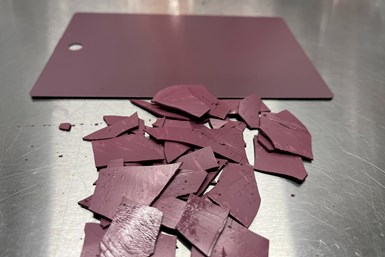Powder coating has been around for more than half a century and is known as one of the best processes for finishing products with durable, even coating. It is an inherently green process, since no solvents are used in its application and the overspray can be captured and reused. Companies usually take the collected powder and repackage it or bake it to harden it to bricks and send it to a landfill. Some estimates for how much powder paint is sent to landfills every year are as high as two billion pounds. That’s an extraordinary amount of waste for products that could be repurposed.
Dwayne Behrens joined Surplus Coatings in Kent City, Michigan, in 1995, before recycling was as prolific as it is today, especially in industrial settings. He saw a need to develop innovative uses for powder coating generated by manufacturer overruns, incorrectly formulated colors that didn’t meet specs or obsolete products. In 2001, he bought the company and has been working to innovate and imagine a world where powder coating doesn’t end up in a landfill but finds a second life. He hired Brian Spicer, a former military chemical operations specialist, and Matt Johnson, who had spent his career at a major paint and coatings company, to help tackle this challenge and Innovakote was born.
Spicer explains that the philosophy was to sell powder coatings for “what they were and not what they were supposed to be.” They were getting increasing calls from companies that wanted to offload their junk powder or waste, but that wasn’t something the company was able to handle at that point. Spicer says that Surplus Coatings was already recycling over 125 million pounds of powder coating, and he learned there was still an estimated two billion pounds sent to landfills worldwide. He wondered how they could do more. So, he and Behrens and Johnson traveled the world looking for ideas on how to do it themselves.
“We partnered with a lot of individuals overseas looking for ways to handle the world’s (powder coating) waste,” Spicer says. “But in the process, we found there really wasn’t one way to do it or one method that could handle the type of waste that is generated in our industry.” So Innovakote went to work and created highly specialized equipment that takes 100% waste powder coating and recycles it into new, virgin powder coatings that can be resold.

“Waste” overspray received for recycling.
Photo Credit: Innovakote
Surplus began to track how much customers ordered and how much was sent back to be recycled. During this auditing process, they saw that about 40% was sent back to them to recycle. “We evaluate the material they provide in samples, analyze it and then determine together what products we can supply back to them from their own waste that are suitable for their applications,” Spicer says. “As we go through this, the customer can see the circular economy this creates. They are saving on landfill and disposal costs and can buy new materials made from their waste to be reused. They remove the greenhouse gases that are associated with the raw materials, and they get a material that meets their specs at a lower cost with a much lesser environmental impact.”
Spicer said that the industry has become complacent with the amount of waste generated and put in landfills, and he hopes that changes. “Powder coating is so environmentally friendly that people are okay to throw 52% into the landfill and not give it a second thought. But when you start to think about other aspects, with an average cost of new powder of $3.50 to $3.75 a pound, that’s a lot of product and money we’re throwing out from an economical point of view. And there’s no reason to mine these raw materials from the earth to create this product and only use less than half of it.”

Simulation of how feedstock will respond to recycling methods. The speckled top part shows “before” and the darker bottom shows “after.”
Photo Credit: Innovakote
Innovakote started with the local office furniture market, knowing their standards would be stringent. “We can use the waste they generate, develop new or modified colors, and then figure out how to best use them in their production.” There are limitations on what colors can be created. They request that customers keep their waste as segregated as possible, to ensure the best outcomes. Customers separate and segregate their paint by color. Innovakote verifies that it’s separated properly, and then goes through a series of tests and filtration to remove contaminants that inevitably find their way into the bins, from earplugs to cigarette butts. Most of the colors they create for the furniture customers are earth tones, but they can do other colors. The main issue is customers keeping their like colors segregated to make reformulating easier. “If a customer has 90% blacks and whites and 10% yellow, we ask them to keep the yellow separate to make reformulating much easier,” Spicer says.

Panel made from 100% recycled content.
Photo Credit: Innovakote
Limitations still exist
Even though recycling is possible, it’s not always easy or accessible for many powder coaters. Chris Sutton, owner of Eagle Environmental in Frazeysburg, Ohio, has built a business on finding new homes for a variety of non-hazardous waste streams from manufacturers, and powder coating is a large part of the business. Eagle works with a variety of manufacturing customers, and even accepts products such as pallets from engine manufacturers that have been contaminated by oil and grease. The pallets are sent to a company to be ground up and formed into briquets that are sold to power plants and large processing plants as a fuel source for their furnaces. As long as it’s non-hazardous, Sutton and his team are committed to preventing materials from going into landfills whenever possible.
“We work with recycling companies in the U.S. and overseas to process our customers’ waste streams,” Sutton says. “With millions of tons of waste generated each year, and companies committing to zero waste by certain dates in the future, we saw an opportunity.” They’ve found the large waste management companies don’t find it worthwhile to work with some of the smaller companies because of their limited volume, but Eagle finds a way and continues to grow based on its reputation and client list.

An overhead shot of Eagle Environmental’s warehouse of materials being prepared for recyclers.
Photo Credit: Eagle Environmental LLC
With only 10 employees, Sutton estimates they process at least half a million pounds a month for true recycling, but process about 800k pounds of materials. Compared to others, that might not be a lot, but it’s enough to keep them busy. “We spend a lot of time prequalifying materials from our customers, testing to ensure we can work with it,” Sutton says. “Customers define everything from how they package waste, to if it’s one color or blended, what types of materials are involved (such as epoxy, urethane or polyester), etc.” Eagle then reaches out to their recycling partners to find a solution.
Not everything can be recycled, so Eagle finds companies that use the waste as an absorbent material or additive. Powder coatings are still sold to cement companies or manufacturers of industrial carpet glues to be used as binding agents. They are also used as absorbent material for other non-hazardous chemical spills and eventually go to a landfill as a byproduct.
Sutton says that recycling and environmental businesses like his are changing quickly. “It’s not quite as fast as the tech world changes and grows, but finding environmental avenues for materials is almost changing at the speed of tech in televisions and PCs. It seems like quarterly there is a new niche that someone has created to recycle something. I don’t usually say no because there is seemingly infinite potential to recycle materials. It just takes some due diligence to find out how.”
Related Content
TTX’s Automated Conveyor Carrier System Offers Wireless, Flexible Operation
ACC system designed for reliable, consistent point-to-point movement of everything from small to heavy parts.
Read MorePowder Coating Overcomes Post Forming
Six Sigma methodology, open communication, and collaboration produce results for leading boat manufacturer.
Read More12 Ways to Improve Your Powder Coating Quality
Often overlooked powder coating procedures that can help you elevate your quality, streamline your operations and improve your profitability.
Read MoreSelecting the Right Outdoor-Durable Powder Coating
The powder coating industry offers an array of chemistries to provide an excellent match to the manufacturer’s expectations for outdoor durability.
Read MoreRead Next
Education Bringing Cleaning to Machining
Debuting new speakers and cleaning technology content during this half-day workshop co-located with IMTS 2024.
Read MoreDelivering Increased Benefits to Greenhouse Films
Baystar's Borstar technology is helping customers deliver better, more reliable production methods to greenhouse agriculture.
Read MoreEpisode 45: An Interview with Chandler Mancuso, MacDermid Envio Solutions
Chandler Mancuso, technical director with MacDermid Envio discusses updating your wastewater treatment system and implementing materials recycling solutions to increase efficiencies, control costs and reduce environmental impact.
Read More












.jpg;maxWidth=300;quality=90)









